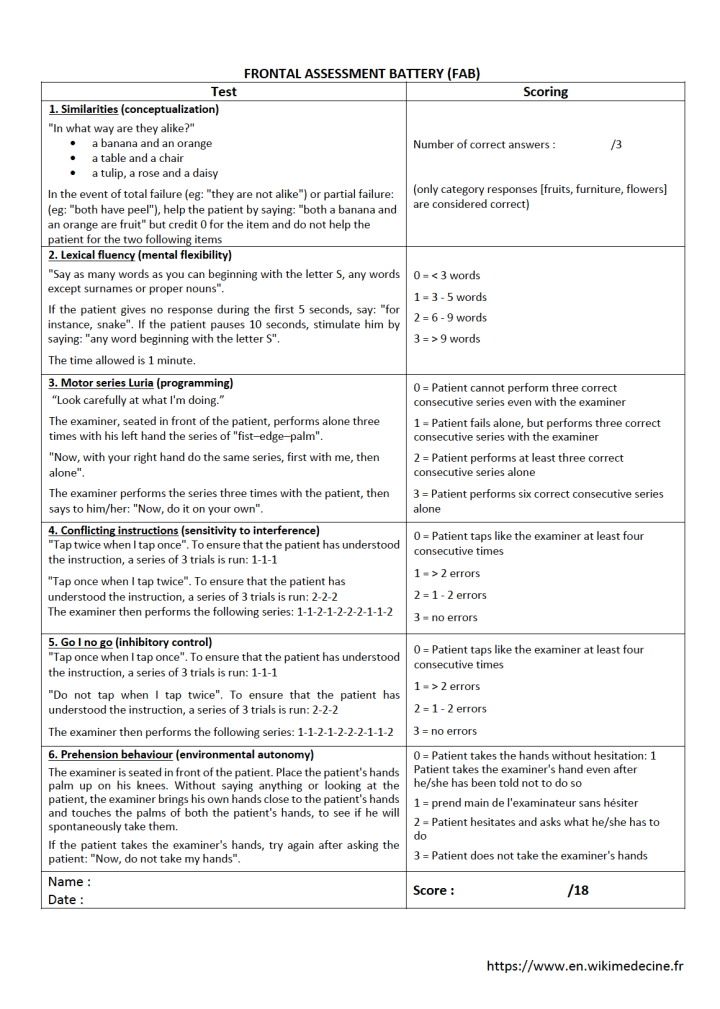Frontal Assessment Battery (FAB): Difference between revisions
No edit summary |
No edit summary |
||
| Line 27: | Line 27: | ||
Slachevsky A et al., Frontal Assessment Battery and Differential Diagnosis of Frontotemporal Dementia and Alzheimer Disease, Archives of Neurology, 2004 61(7): 1104-1107 | Slachevsky A et al., Frontal Assessment Battery and Differential Diagnosis of Frontotemporal Dementia and Alzheimer Disease, Archives of Neurology, 2004 61(7): 1104-1107 | ||
2015 Review of consensus versions of cognitive tools according to GRECO (Groupe de Réflexion sur les Evaluations Cognitives) | 2015 Review of consensus versions of cognitive tools according to GRECO (Groupe de Réflexion sur les Evaluations Cognitives){{Lien espagnol|Article=Batería de evaluación frontal (Frontal Assessment Battery - FAB)}} | ||
[[Category:Clinical tools]] | [[Category:Clinical tools]] | ||
[[Category:Neurology]] | [[Category:Neurology]] | ||
[[Category:Geriatrics]] | [[Category:Geriatrics]] | ||
Revision as of 16:23, 7 October 2023
The Rapid Frontal Efficiency Battery (BREF) is a specific screening test for dysexecutive disorders commonly used in the evaluation of dementia syndromes, usually in conjunction with a more general test (such as an MMSE).
A score below 16 (15 in the case of cultural level < 3 = primary = CEP) is considered abnormal but is not very specific. A score below 12 has good specificity (Se 77%, Sp 87%) for identifying fronto-temporal dementia if the MMSE is above 24 (in other dementias such as Alzheimer's disease, all tests are impaired at a more advanced stage).
It can be downloaded with its norms as a pdf :
As a reminder, the suspicion of a dementia syndrome (or of a loss of autonomy or depressive affects in an elderly patient) should lead to a first-line examination:
- A complete history and clinical examination
- Cognitive assessment using MOCA or MSSE + BREF
- A mini-Cog is an acceptable alternative to systematic screening (to be performed annually on all geriatric patients).
- Assessment of autonomy via an IADL (ideally, compare answers with someone close to the patient)
- Affect assessment via a GDS
In the event of positive or doubtful results, cognitive testing by a neuropsychologist should be carried out as a second line.
Author(s)
Dr Shanan Khairi, MD
Bibliography
Dubois B et al, The FAB: a Frontal Assessment Battery at bedside, Neurology, 2000 Dec 12;55(11):1621-6
Slachevsky A et al., Frontal Assessment Battery and Differential Diagnosis of Frontotemporal Dementia and Alzheimer Disease, Archives of Neurology, 2004 61(7): 1104-1107
2015 Review of consensus versions of cognitive tools according to GRECO (Groupe de Réflexion sur les Evaluations Cognitives)
